Anointing Oils & Unguents
Immerse Your Senses in the Scented Luxuries of Ancient Egypt!
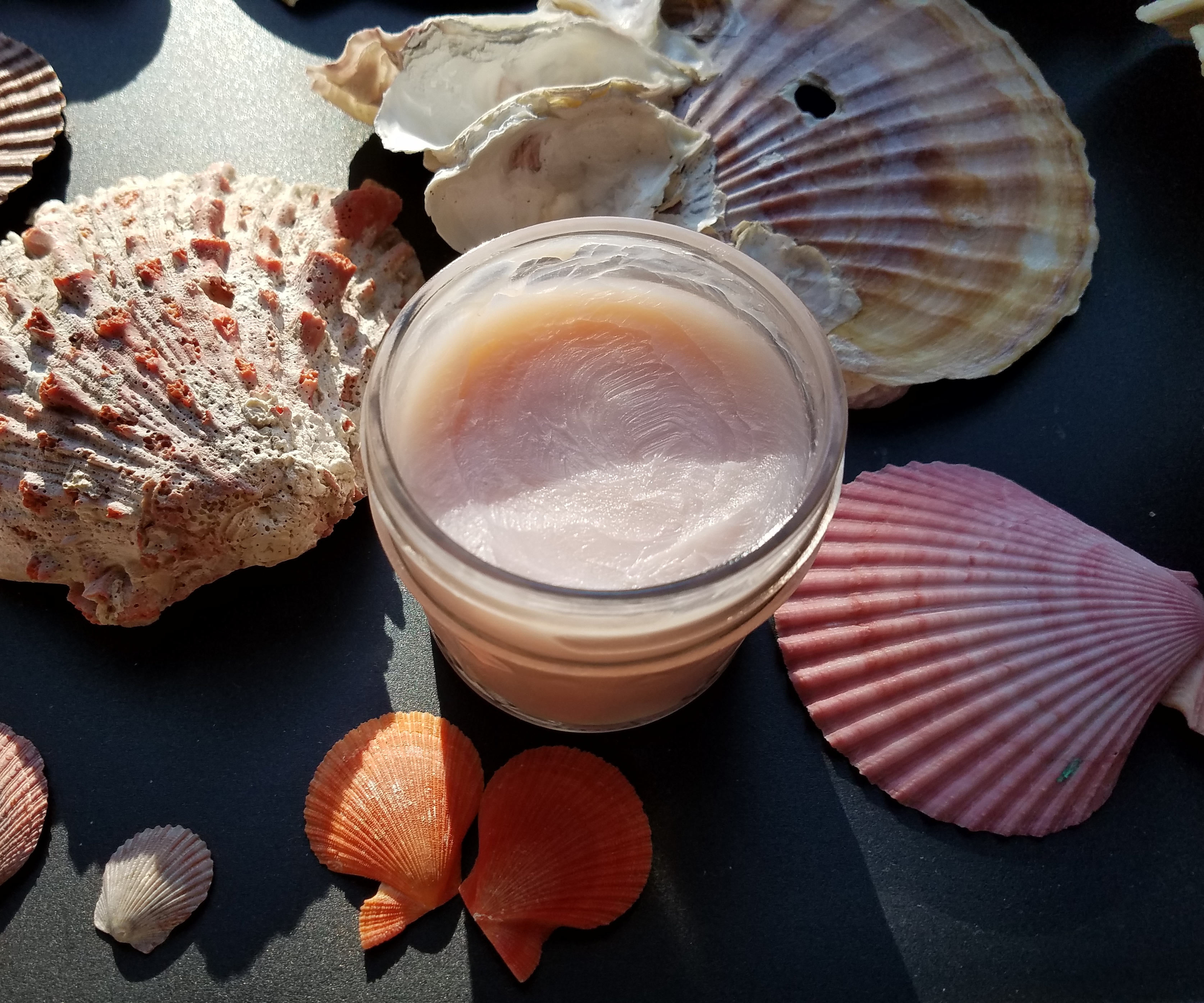
𓋹
Nudj Immortelle Skin Care / Unguent
Wandering Stars’ Nudj Immortelle, our popular exclusive skin care unguent, uses an all natural ingredient formula based upon ancient Egyptian recipes inscribed on temple walls.
This lovely and fragrant deep moisturizing skin care emollient has a wonderful slip and glide with it's Tallow and Argan oil base, but it's the synergistic healing properties with the other essential oils that is most amazing!
Just six simple ingredients: cosmetic grade organic grass-fed beef Tallow, Argan and Moringa oils, infused with Frankincense Boswellia serrata and Helichrysum italicum essential oils, with natural Alkanet root for its lovely seashell pink color. No preservatives or artificial anything, with a natural long shelf life, guaranteed to be used up long before then.
Use all-over after bath or shower, with water or alone, on dry cracked feet and hands, rough elbows and knees. It’s gentle enough for use on the face and neck - even on your delicate eyelids (anywhere in fact); but it goes right to work to heal even the most damaged dry skin. The delightful healing fragrance lasts for just a short while, and dissipates quickly, so it does not compete with other perfumes or fragrances.
Several of my customers have told me that this is an amazing pomade for thick hair. I would not be surprised, as we often see Egyptian women depicted with unguent cones on their heads, whether with their own hair or wigs. All of these ingredients are truly divine for hair.
Women have also reported that they love it as a “bosom balm” for their décolletage and to smooth out sun-damaged skin. There is no oil closer to that of human skin than cosmetic grade tallow - hands down.
Helichrysum italicum essential oil is quickly becoming world renowned for skin healing, especially after cosmetic surgery, and for reduction redness and sweiiling associated with Rosaceae, spider veins, etc. See the clinical research in the links below. It is edifying to see that Wandering Stars was on the cutting edge of this research back in 2018, bringing back the long-lost ancient Egyptian medical knowledge left to us in temple inscriptions and papyri.
Try an inexpensive 5 ml sample today! We’re pretty sure you will soon be back for more…
Nudj Immortelle is always made in small batches, so it is always fresh!
Available in 2 ounce jars. $33
See also: Frankincense & Myrrh
Helichrysum Clinical Research Links:
Effect of Helichrysum italicum in Promoting Collagen Deposition and Skin Regeneration
and
Beneficial Effects of Helichrysum italicum Essential Oil
NOTE: We have had several requests for a “vegan” version of our Nudj Immortelle, with Shea butter usually suggested as being the closest of all the vegetable oils to our cosmetic-grade tallow. Below is a chart comparing the fatty acid percentage of tallow compared to Shea butter:
Fatty Acid - Tallow /Shea Butter
Lauric Acid - 2 / 0
Myristic Acid - 6 / 0
Palmitic Acid - 28 / 5
Stearic Acid - 22 / 40
Oleic Acid - 36 / 48
Linoleic Acid - 3 / 6
Linolenic Acid - 1 / 0
As you can see, Shea butter is rather lacking in comparison. In addition, Shea butter contains fine particulates called unsaponifiables, and these make Shea butter comedogenic, that is, it tends to clogs pores and creates black heads - mabe great for rubbing on the body, but wearing heavy and greasy, especially on the face. As you can guess, being nearly identical to our human skin oils, tallow does not clog pores and is healthy for the most delicate skin types.
All in all, Shea butter is twice the cost of tallow, is lacking the total fatty acid complex of human skin oil and of tallow, and really shouldn’t be used daily on the face or eye area, especially if one is prone to clogged pores. As such, because of these drawbacks, and because there are no ancient Egyptian recipes for unguents using vegetable oils, Wandering Stars will not be producing a vegan version at this time. Simply put, ‘The Egyptian’ is dedicated to producing authentic reproductions of the ancient Egyptian Sacred Oils and Unguents, and will remain so for now.
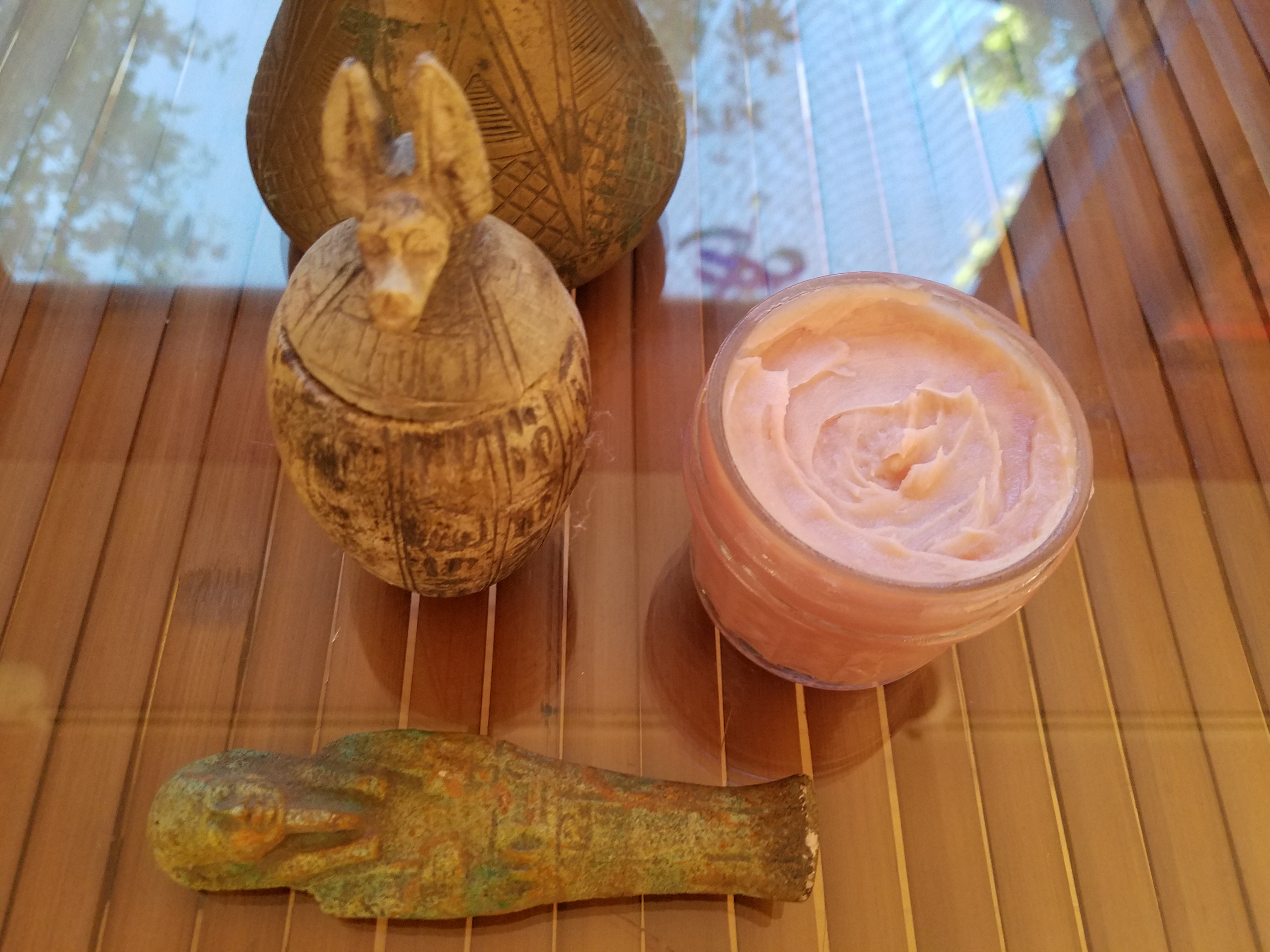
𓎯
Madjet - Temple Anointing Unguent
Our Madjet Temple Anointing Unguent is formulated from an ancient recipe carved in hieroglyphs in the temple of Horus at Edfu Egypt. Used primarily as a cone-shaped offering heaped in Merhet jars, such as is represented in the hieroglyph of the tied jar above that represents them, and was an anointing unguent for the statues of the gods, as well as for the dead.
Madjet unguent was often worn in the shape of cones upon the heads in depictions of both the deceased and of women at banquets and funeral processions, with a fresh blue lotus flower either inserted in it or attached to a headband - sometimes with a yellow mandrake fruit offered to the nose.
For the same olfactory effect try using Madjet in conjunction with our Seshen Blue Waterlily Perfume, our Sacred Wadjet perfume, or Madjet - one of the 5 Perfume Oils collection. Intoxicating…
If the Neteru allow, you will be able to add a whiff of our exclusive Reremet Mandrake oil (hopefully coming soon), and cross the threshold into 7th Heaven! In accordance with the bas-relief carvings and inscriptions in the sanctuaries of the temple of Seti I at Abydos, they all have a magical synergy with the Kepu temple incense all the while…
Like our popular Nudj Immortelle, Madjet unguent uses cosmetic grade Tallow, and has the same skin and hair friendly slip and glide with the Argan oil, but with the penetrating warming effect of Cinnamon and Pistachia terebinthus essential oils, making it invaluable for therapeutic massage.
Along with these is a complex fragrance medley of locally collected Sweet Acacia flowers, Maritime Pine oil from Turkey, Juniper, and Myrrh from Africa, topped off with deep healing Moringa oleifera oil infused with natural root Alkanet for it’s unique rosy color (which has it's own anti-microbial qualities).
If you are a massage therapist, try a some along with your favorite non-fragrant oil and see what happens for yourself! It has warm and deep penetrating properties similar to, yet not as overpowering, as Tiger Balm, which relaxes tight sore muscles - along with a delightful light scent that doesn't linger.
CAUTION: This unguent contains Cinnamon bark oil, which can be a skin irritant even at the subdued amount in this unguent. Use judiciously at your own risk. Pregnant women should not use this product.
Read about it in our article: The Seven Sacred Oils
Available in 2 ounce jars. $44
.jpg)
𓆸
Seshen - Egyptian Blue Waterlily Perfume
Mistakenly called a "lotus" since the 1800's, the flower of this indigenous Nile waterlily played a predominant role in the ancient Egyptian culture for thousands of years! The wise ancient Greeks knew it was a waterlily, their word for lily, Sousinon, derives from the Egyptian word Seshen, represented by the single hieroglyph above.
Revered for over three millennia, quantities of fresh-cut Egyptian blue waterlily flowers were presented daily by the Egyptian priests as altar offerings in the sanctuaries of the gods or Neteru, with their sacred scent pervading the Temple chambers.
In the fabulous bas-relief inscriptions at Seti I’s magnificent temple at Abydos, we see the pharaoh offering copious amounts of fresh-cut blue waterlily bouquets to the Neteru - most especially to Osiris and Horus. The hieroglyphs all attest to just how much the gods appreciate these offerings. From Lise Manniche in her "Sacred Luxuries":
The king offering 'lotus' to a deity is a ceremony frequently depicted on the inner walls or columns of the temple. The deity is said to be ‘satisfied’ by the 'lotus' flower and his/her heart ‘appeased’ by its scent. The god ‘enjoys the divinity’ of the scent. When the god sees the brilliance of the flower, his ‘eyes marvel’ and when he sniffs its scent, his ‘nostrils dilate’. The god in turn will acknowledge the offering by saying, ‘I receive your offering and sniff its scent. I cause you (the king) to be praised and loved by means of its scent'
Native to Egypt, its symbols echo throughout ancient Egyptian art and architecture, representing birth and regeneration, and the morning Sun as Ra rising from the Night of the Duat. Thus, the heiroglyph for Seshen (used in the heading) is a waterlily flower bud lifting out of the primordial water.
'The Egyptian' Sacred Scents has secured an exclusive, though seasonal, source of steam-distilled 100% pure organic certified Egyptian Blue Waterlily (Nymphaea caerulea) Absolute Perfume oil - imported direct from Sri Lanka and offered here in limited quantities. This fragrant essential oil truly evokes the living scent of Egyptian blue waterlily flowers - try the 2 ml sample and see for yourself!
Note: Seshen is a concentrated absolute perfume oil. While it can be safely applied directly to the skin as a stand-alone perfume, it is most often diluted in carrier oils, or in perfume mixtures such as our Wadjet, and can be added to unscented massage oils. It is particularly well-suited for water-based essential oil diffusers with the lovely olfactory effect of fresh-cut flowers!
Read our article: Seshen - Egyptian Blue Waterlily
Shipped in amber glass bottles with dropper seal, filled by volume. Bottle sizes and prices are: 2 ml - $7.00, 12 ml - $33.00, and 30 ml - $80.00.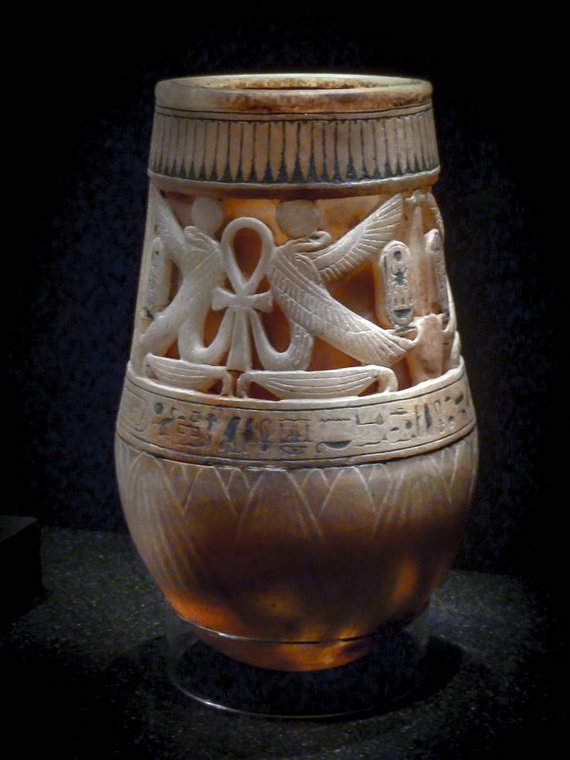
𓆘
Wadjet - Perfume Oil
Wadjet Perfume Oil was developed from ancient Egyptian temple inscriptions and papyri for a truly magical olfactory experience!
A small intricately carved calcite jar bearing images of the serpent goddess Wadjet (photo and heiroglyph above) was discovered in Tutankhamun’s tomb in the Valley of the Kings containing the remains of ingredients in our Wadjet reproduction, and so we named our perfume 'Wadjet.'
Ingredients: Blue Waterlily absolute (Nymphaea caerulea), Mastic (Pistachia terebinthus), Frankincense Maydi (Boswellia frereana), Juniper (Juniperus communis), Myrrh (Commophora myrrhum), and Moringa oleifera pure essential oils.
Shipped in amber glass bottles with dropper seal, filled by volume. Bottle sizes and prices are: 2 ml - $7.00, 12 ml - $31.00, and 30 ml - $77.00.
About the Serpent Goddess Wadjet
The protective goddess Wadjet (in ancient Egyptian: wꜢḏyt "Green One") was said to be the patron of Lower Egypt, and upon unification with Upper Egypt, the joint protector and patron of all of the Egyptian goddesses, or Neteret, of Egypt.
𓆗
The cobra image of Wadjet is called the Uraeus, and it was the emblem of protection on the crowns of pharaohs and their queens, at the place of the third eye or pineal. She was also the protector of women in childbirth. Wadjet was said to be the nurse of the infant god Horus called Hoor-pa-kraat. With the help of his mother Isis, they protected Horus from his treacherous uncle, Set, when they took refuge in the swamps of the Nile Delta.
𓂀
Wadjet was closely associated in the ancient Egyptian religion with either the Eye of Ra, or of Horus, two powerful protective solar deities who were often joined as one god-form - Ra Horakhty. Her solar symbol (below) crowned the god form's head in temples, tombs and magickal papyri. The well-known hieroglyph for her eye, the Wadjet or Udjat eye (pictured above), and was a common protective amulet for commoners and kings alike. Sometimes two eyes are shown together, gazing at the viewer, and are said to be the eyes of the dead watching the living on coffins, and symbolize the Sun and Moon.
𓇴
Per-Wadjet, the temple or house of Wadjet, always contained a sanctuary or “birth house” within the temple precinct. Called a mammisi - this smaller temple structure was dedicated to Isis and the child Hoor-pa-kraat, who is interpreted to represent the pharaoh she protects. Thus, in New Kingdom times, Wadjet became associated with Isis as well as with many other goddess deities, and was often depicted together with the vulture Goddess of Upper Egypt, Nekhbet, who filled much the same role. These two together were a symbol of the unity of Upper and Lower Egypt for the remaining millennia of Dynastic rule.
𓅒
"The Two Ladies"
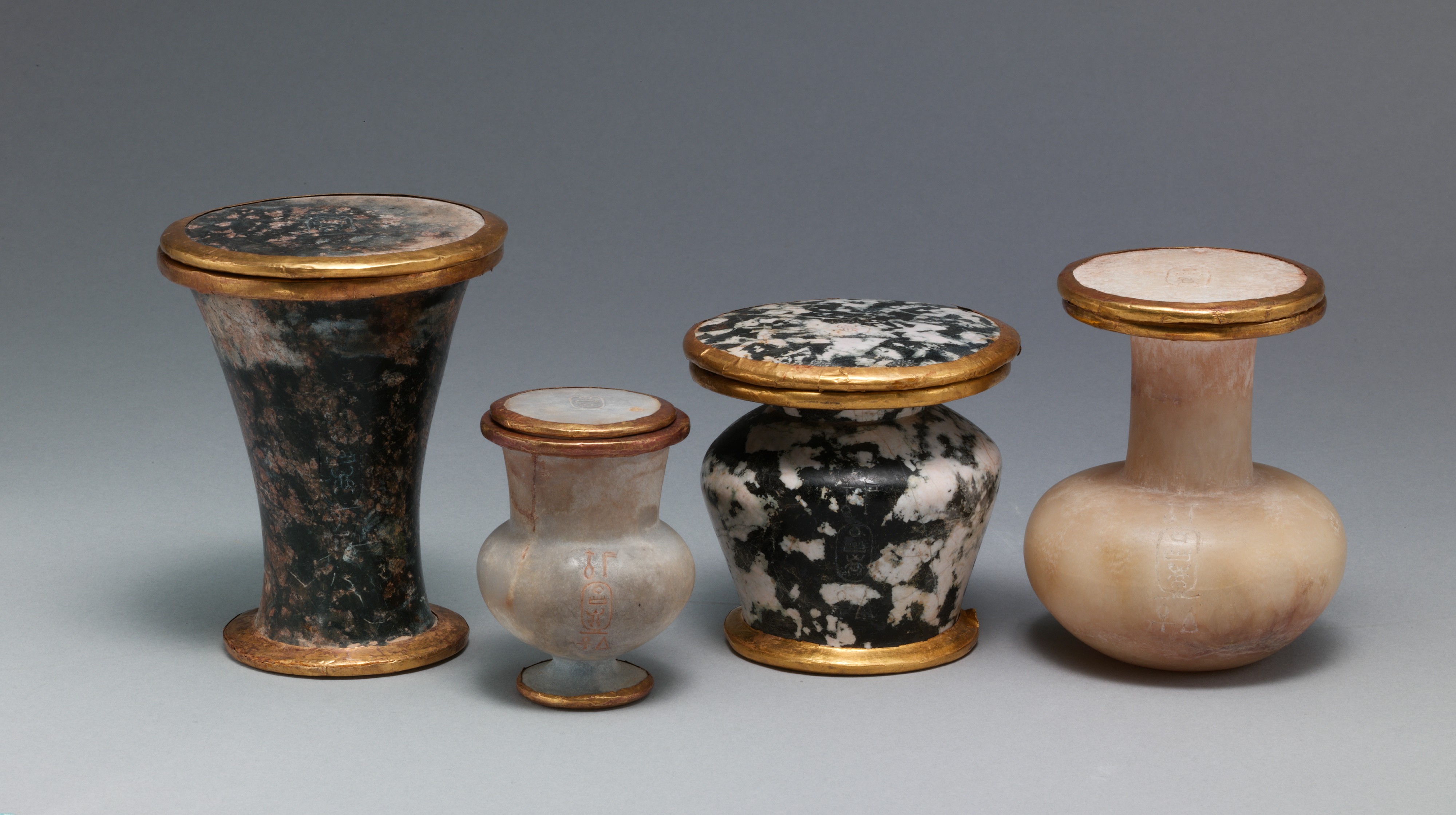
Sacred Merhet Oil Jars belonging to 18th Dynasty Pharaoh Thutmoses III - courtesy the Metroplitan Museum of Art
𓁢
The Seven Sacred Oils of Ancient Egypt
Wandering Stars and ‘The Egyptian’ Sacred Scents are proud to present a full set of authentic reproductions of the highly fragrant Seven Sacred Oils listed in the tombs and temples of the pharaohs and gods dating back to pre-history.
The formulas for our seven anointing oils are based on the ingredient lists carved in hieroglyphs in the Temple of Horus at Edfu, Egypt. Used in the process of mummification, these anointing oils fell under the jurisdiction of, and were sacred to, the jackal-headed god-form Anubis - whose hieroglyph appears above.
The Seven Sacred Oils are always listed in this order: Seti Heb, Hekhenu, Sefet, Nekhenem, Tuat, Hat n Ash, and Hat n Tjhenu, and each had a unique bottle or jar shape to identify them (see below). Collectively called Merhet, and venerated by the ancient Egyptians since pre-dynastic times, the Seven Sacred Oils have been brought back to life by Wandering Stars, to once again soothe the skin and waft into the nostrils of both mortals and the gods for the first time in nearly 2,000 years.
Read about them in our article: The Seven Sacred Oils
Shipped in amber glass bottles with dropper seal, filled by volume. Bottle sizes and price for a set of all seven oils are: 2 ml - $33.00, 12 ml - $156.00, or 30 ml - $333.00.
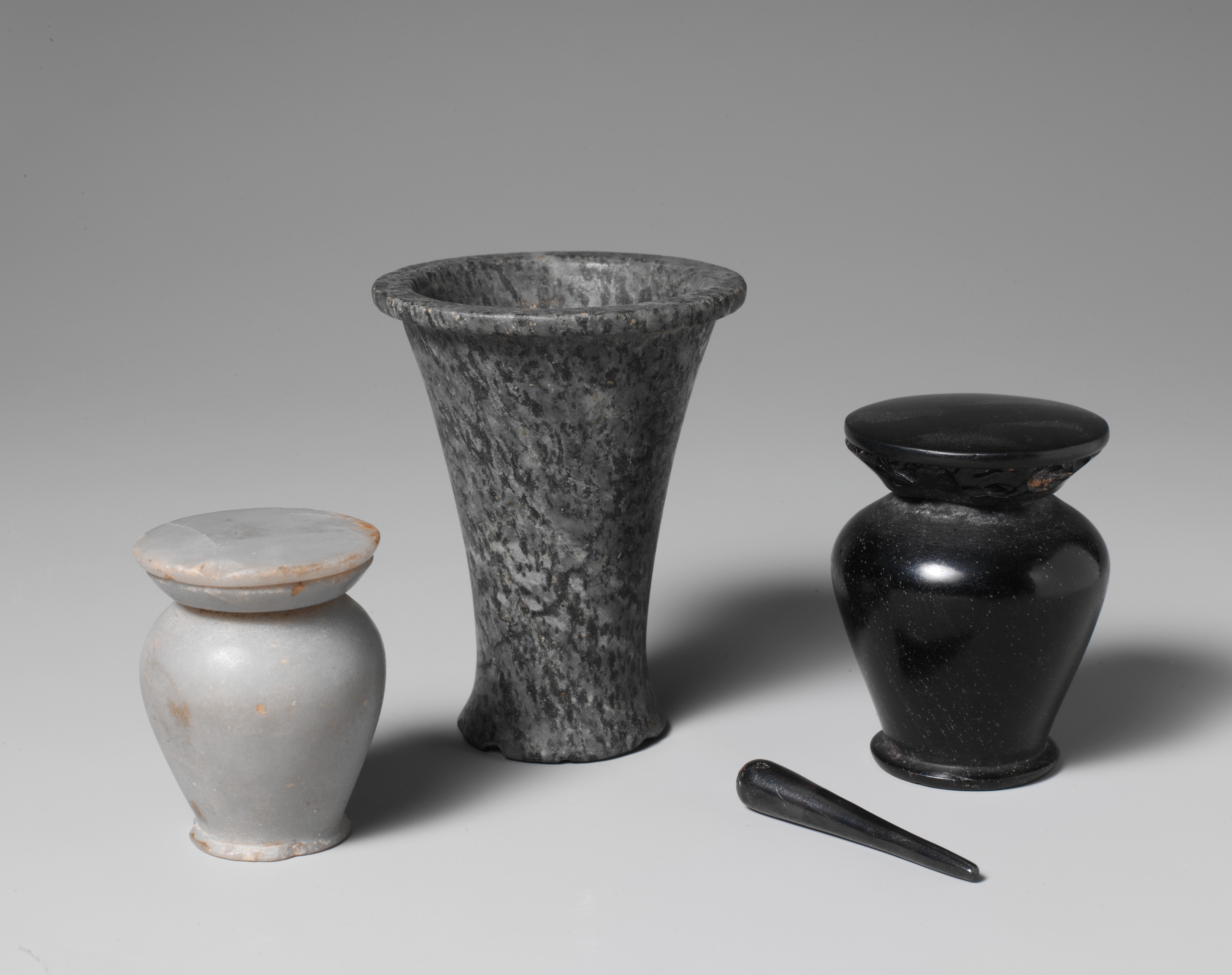
Stone perfume oil Jars and kohl jar, photo courtesy the Metropolitan Museum of Art.
𓃣
The Five Additional Temple Perfume Oils
In addition to the Seven Sacred Oils which were considered a staple in temple and funerary ritual since the pre-dynastic era prior to 3500 BCE, there arose in the New Kingdom Five additional sacred perfumed oils, all listed together for the first time in the temples of the great pharaohs, Queen Hatshepsut and Seti I, father of Rameses II. They continued to play an essential role, all or in part, with temple rituals for another thousand years.
Lists of these Five (Madjet, Bak, Ibr, Senetjer, and Antiu) along with their ingredients were also discovered carved on the walls of the Temple at Horus at Edfu, built circa 350 BCE.
Each is a divine perfume in its own right, but when they are applied sequentially, the combined fragrances are out of this world! Try our 2 ml sample size Set of 5 today and see for yourself!
Read about them in our article: The Seven Sacred Oils
Shipped in amber glass bottles with dropper seal, filled by volume. Bottle sizes and price for a five bottle set are: 2 ml - $22.00, 12 ml - $93.

𓆰
Merhet Nar - Spikenard Anointing Oil
Sacred and precious Spikenard oil was known in very ancient times, and is derived from the small rhizomes and umbelliferous flower heads of the Nardostachys jatamansi plant, which is native to India, and Nardostachys grandiflora from Nepal. Nard is noted for it’s very unique earthy, yet sweetly intoxicating and lingering scent.
It was obtained as a luxury in ancient Egypt from the Near East as early as 1478 BC, the time of Queen Hatshepsut, who is said to have preferred the scent during her New Kingdom reign as Pharaoh. The Egyptians traditionally stored the “Oil of Nar”, called Merhet Nar, in alabaster 'Bas' containers such as those pictured above (especially the one on the far left), to preserve its fragrance. This is the expensive “nard ointment” in an "alabaster jar" that the biblical Mary poured upon Jesus’ head, anointing him for burial.
Our Merhet Nar is made with a perfumer's dilution of 20% pure Spikenard flower oil from Nepal, in a carrier of fine Moringa peregrina oil from Oman.
Read more about it in our article: Merhet Nar - Spikenard Oil
Shipped in amber glass bottles with dropper seal, filled by volume. Bottle sizes and prices are: 2 ml $6.00, 12 ml $27.00, or 30 ml $65.
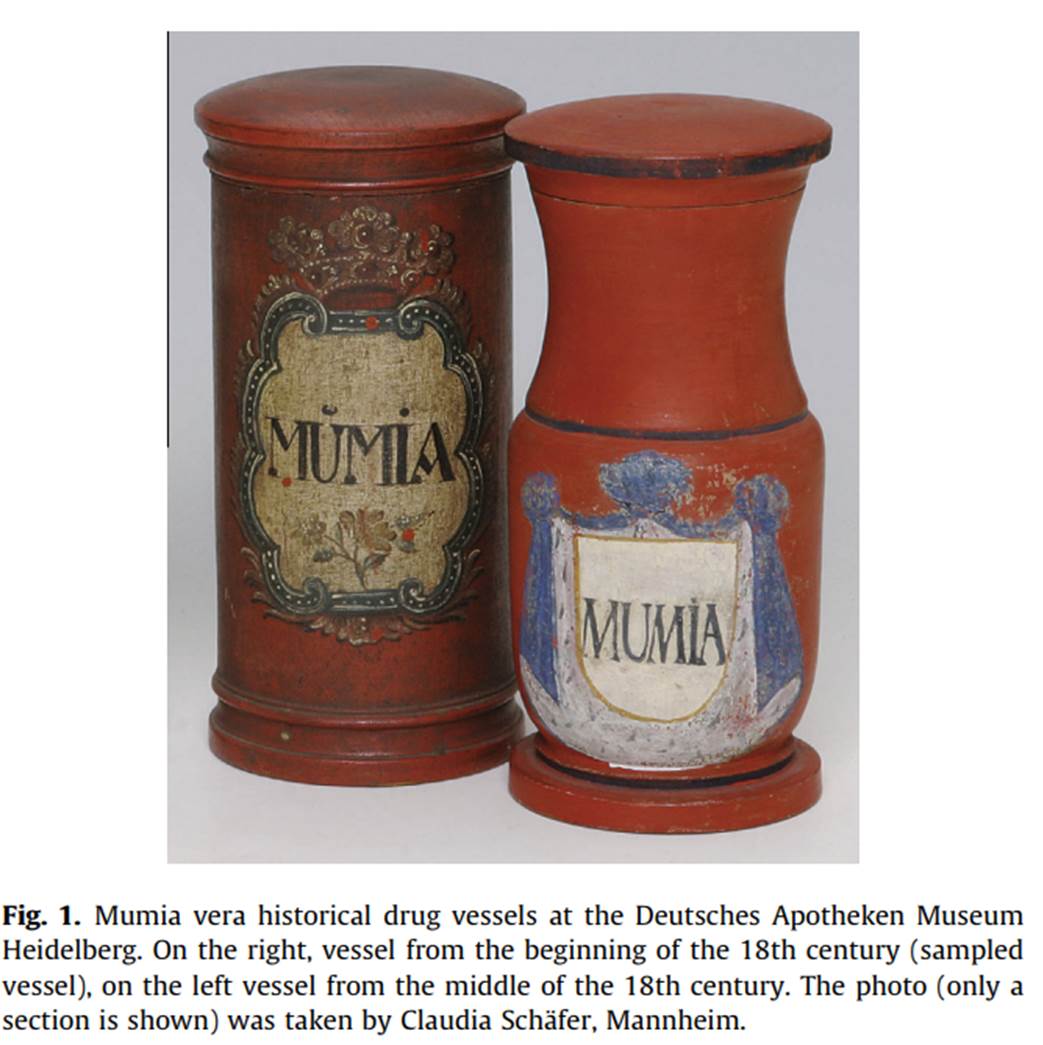
𓁀
Mumia - Healing Oil
Mumia vera aegyptiaca, was an oil or a powder taken from ancient Egyptian mummies or scraped from the bottoms of their coffins, and was considered an exotic cure-all for hundreds of years, with reference to mumia being found in medical literature from the 8th through to the 20th centuries.
Mumia or mummia is the Latinized version of mumya, the Arabic word for bitumen, a naturally occurring form of black tar, which is one of the recurring ingredients in the Seven Sacred Oils used by the ancient Egyptians to preserve mummies. It from this word that the term “mummy” originally came, since mummies were literally blackened by this bitumen based oil mixture.
The substance was a part of the Materia Medica of early physicians in Persia around 865 CE, who likely had an inkling as to what it actually was, and was primarily prescribed to heal wounds, bruises and sores. It would later be prescribed to be taken orally - that is by ingestion - and that would could continue up until the 1920's!
The ancient Egyptians would be humorously horrified at the thought of silly future people ingesting ground up mummies, when the actual healing properties were in the anointing oils themselves. Meanwhile it is highly unlikely that dessicated human body ingredients are medicinal in any way. The ancient Egyptians sure didn’t think so, as there is no record whatsoever of such “medical cannibalism” in the surviving medical papyri, although there is plenty documentation of the benefits of their Seven Sacred Oils.
We guarantee that our mumia contains no human body substances, but rather is a mixture of all of our Seven Sacred Oils in one bottle, and is likely very nearly identical in makeup to the coveted mumia that the Persians once used - minus the mummy, of course! Try a 2 ml sample for yourself, and be amazed at its powerful healing and anti-inflammatory properties on wounds, sores, spider and insect bites and rashes!
Read about it in our articles:
Mumia Oil
The Seven Sacred Oils
Shipped in amber glass bottles with dropper seal, filled by volume. Bottle sizes and prices are: 2 ml $5.00, 12 ml $18.00, or 30 ml $44.00.
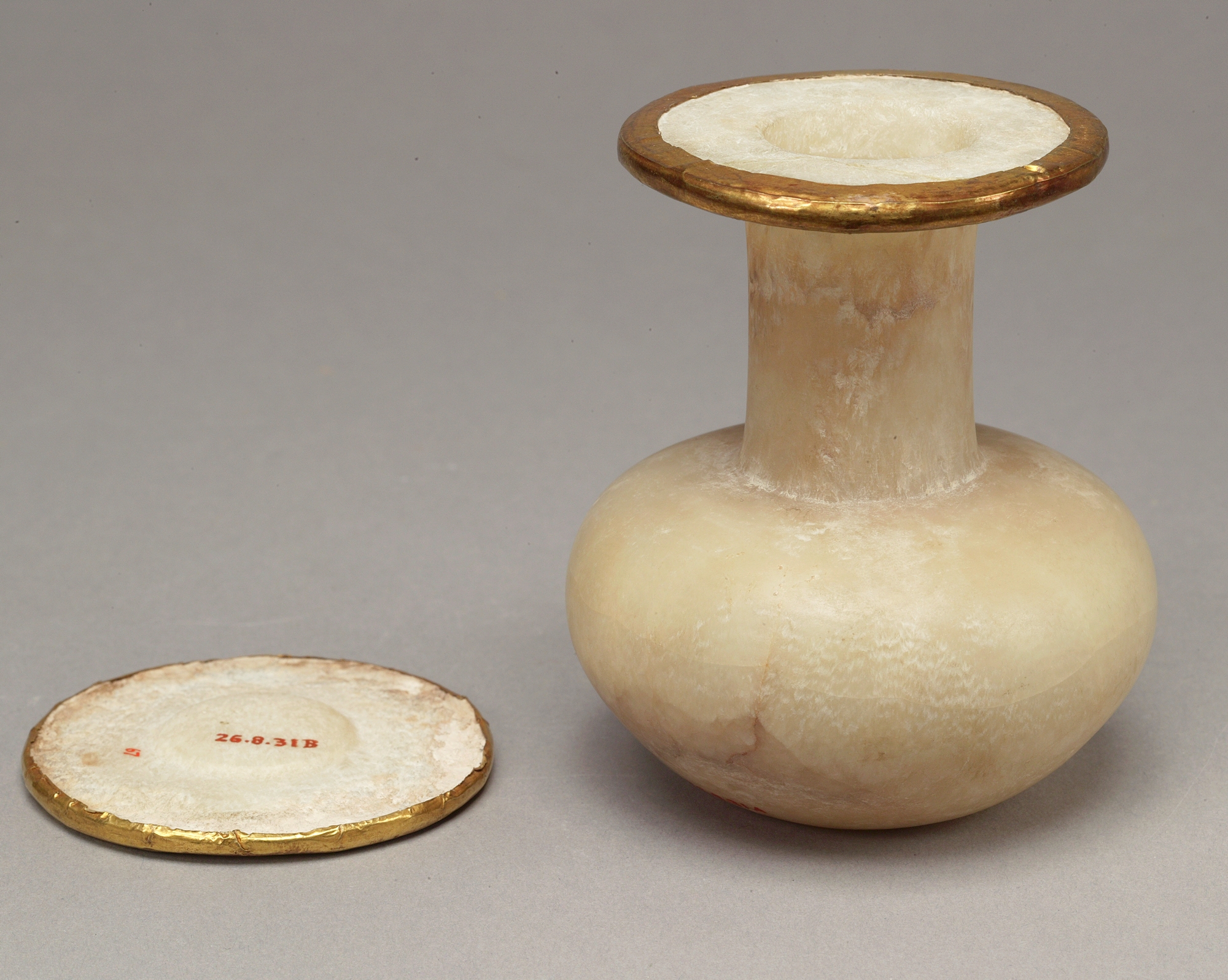
𓅜
Ta-n-akh - Oil of Abramelin - Anointing Oil
A blend of five aromatic botanical ingredients, the Oil of Abramelin is a consecrated anointing oil that was and still is used in ceremonial magic. It is named after a medieval grimoire called The Book of Abramelin, which tells the story of an Egyptian mage named Abraham, or Abra-Melin, who taught a system of magic to Abraham of Worms, a German Jew, presumed to have lived from 1362 - 1458 CE.
The recipe described in Abramelin is clearly an adaptation of the Jewish holy anointing oil recipe of the Tanakh, named after the Canon, and is described in the 3,000-year-old Book of Exodus (30:22-25), attributed to Moses, a Jewish Egyptian trained in the temples. No coincidence, Ta-n-Akh means "offering to the Spirit" in the Egyptian language, used to describe the act of funerary anointing in the Coffin Texts.
The "Akh" or "magically effective spirit" was a concept of the dead that varied little over the long history of Egyptian belief. Relative to the afterlife, the Akh represented the deceased who was transfigured into an effective being of light.
The ingredients of the Jewish Tanakh and Abraham's Oil of Abramelin are identical: Cinnamon, Myrrh, Calamus, and Cassia in an Olive Oil carrier. But there is some discussion about the ingredient Calamus as it appears that it may have been a blind or a mistranslation of Cannabis (more on this in the linked article below).
Abramelin oil became popular in the Western esoteric tradition in the 20th century after the publication of the S. L. MacGregor Mathers English translation of The Book of the Sacred Magic of Abramelin the Mage (1897), and especially via Aleister Crowley, who used a similar version of the oil in his system of “Magick”. There are multiple recipes in use today and the oil continues to be used in several modern occult traditions, particularly Thelema (instituted in 1904 by Crowley).
Mathers and Crowley both used galangal, rather than the calamus of Abraham’s recipe. This gives a far more exotic and less floral effect, but more importantly for their sacraments, it is ingestible - calamus being somewhat toxic if taken internally. Also Crowley gives a huge amount of cinnamon oil, which is clearly beyond toleration on the skin for most of us - and may be another of his famously cruel blinds. We use a 1:14 ratio in ours, though I am happy to formulate his maximum 8:21 ratio upon request… Crowley doubles the amount of cinnamon for one of his recipes, so that's what we do.
Our Ta-n-Akh anointing oil has neither Calamus or Cannabis oils, we leave it out so that you can add your own, and sell the Abraham and Crowley Oil of Abramelin formulas as separate products.
Read more about The Oil of Abramelin in our article Ta n Akh Oil
Choose from three formulas: Ta-n-Akh, Abraham, and Crowley in 2 ml, 12 ml, or 30 ml sizes.
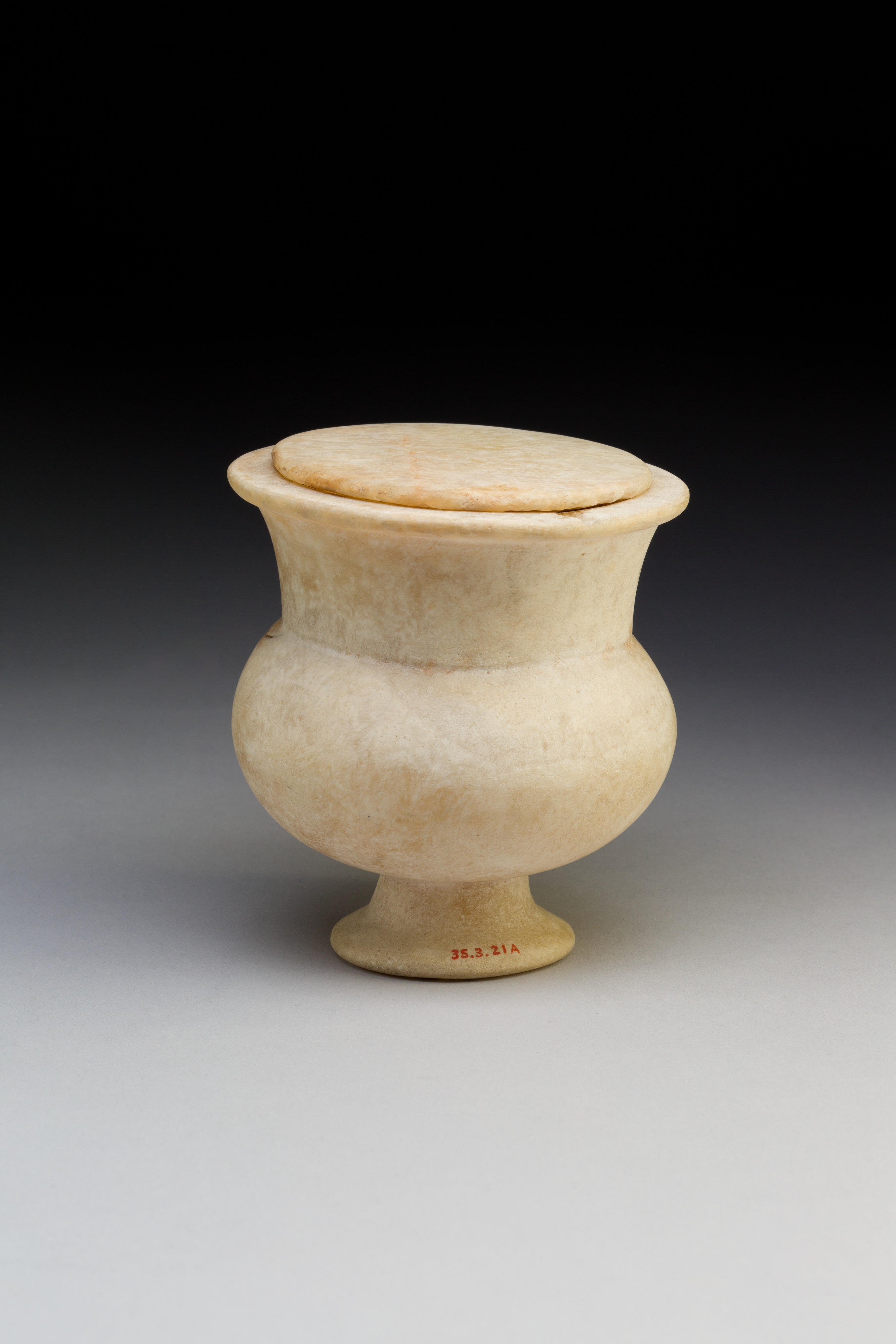
𓈛𓉼
A'ash - Terebinthine Pine Oil
Note: The alabaster jar in our photo, from an ancient Egyptian New Kingdom tomb, was found to contain pine oil residue, and may have been used to contain A’ash oil, which this jar shape represents. Photo courtesy of The Metropolitan Museum of Art.
If the name Terebinth sounds somewhat familiar or similar to turpentine or terpene, that’s because it is: the words both derive from the Latin ‘terebinthus’, which means “turpentine fragrance”. Interestingly, one of the most coveted oil and resin in ancient Egypt is that of Pistachia terebinthus, a non-coniferous producer of “turpentine fragrance”, used in three of our Seven Sacred Anointing Oils, with two others using this Terebinthine Pine essential oil, Pinus pinaster, which they called A’ash, meaning, quite simply ‘pine’.
Clearly the Egyptians were on to something with the aromatic terpenes and bioflavinoids in both. They possess markedly different scents, however. Our Terebinthine Pine is 100% pure Old World Turpentine Pine oil from Pinus pinaster - imported from Turkey.
Herbalist and naturopathic experience has shown that Terebinthine Pine, or Maritime Pine, has active ingredients that provide many health benefits, including, but not limited to, easing upper respiratory congestion and inflammatory skin conditions, especially as a hair and scalp cleansing shampoo additive.
Wandering Stars and "The Egyptian" Sacred Scents is proud and excited to bring this very ancient product back from the past and into the present. Why not try some for yourself? You don’t have to go back to ancient Egypt!
See our article “About Terebinthine Pine Oil” for more information.
Shipped in amber glass bottles with dropper seal, filled by volume. Bottle sizes and prices are: 2 ml $3.00, 12 ml $18.00, or 30 ml $48.00.

>> Medical Disclaimer: Our expertise lies in incense, botanical fragrant oils, and cosmetic skin and hair ointments. The information offered on our website is to the best of our knowledge factual and backed by clinical studies, and is presented solely for your edification and enjoyment. Wandering Stars - 'The Egyptian' Sacred Scents is not a licensed healthcare provider, and cannot give personal medical advice. For your own safety, we do not recommend ingesting any of our products.<<